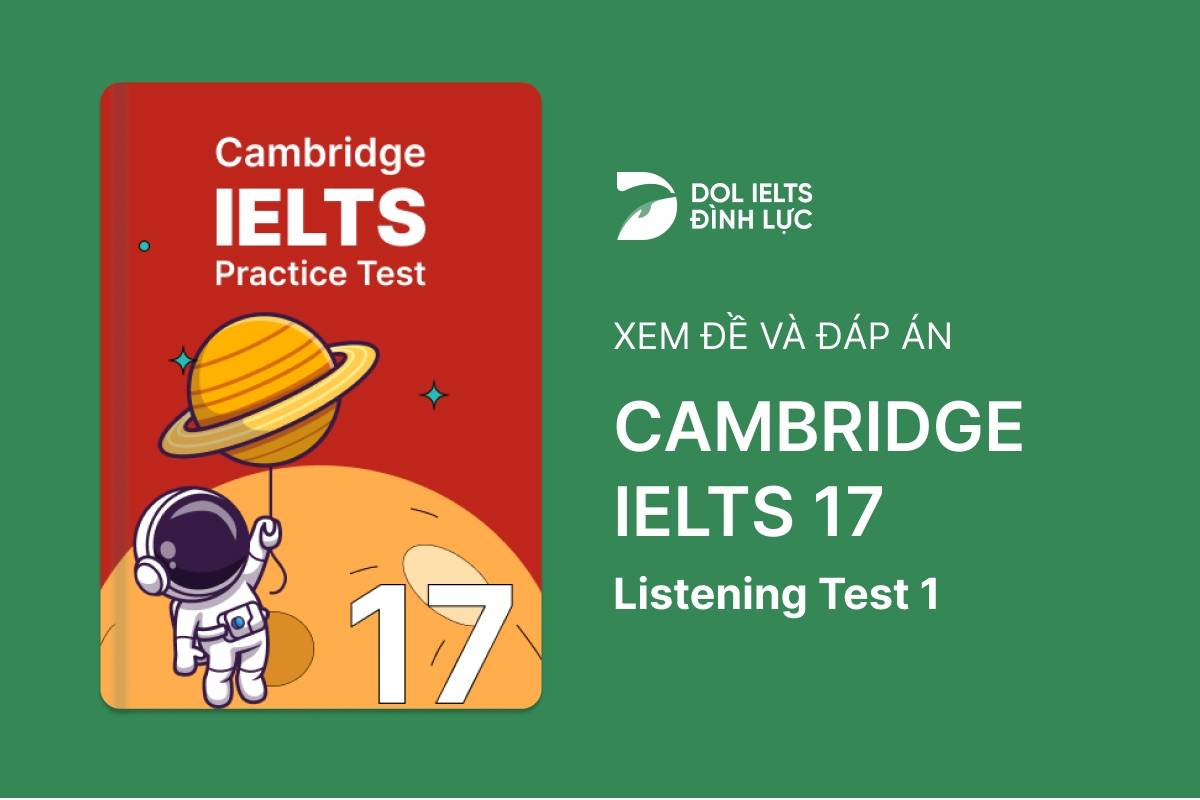Cambridge IELTS 17 - Listening Test 1 With Practice Test, Answers And Explanation
Luyện tập đề IELTS Online Test Cambridge IELTS 17 - Listening Test 1 được lấy từ cuốn sách Cambridge IELTS 17 với trải nghiệm thi IELTS trên máy và giải thích đáp án chi tiết bằng Linearthinking, kèm answer key và list từ vựng IELTS cần học trong bài đọc.
Section
👂️ Bài nghe section 1
Regular activities
Beach
making sure the beach does not have
on it1no
2
Nature reserve
maintaining paths
nesting boxes for birds installed
next task is taking action to attract
to the place3identifying types of
4building a new
5
Forthcoming events
Saturday
meet at Dunsmore Beach car park
walk across the sands and reach the
6take a picnic
wear appropriate
7
Woodwork session
suitable for
to participate in8making
out of wood917th, from 10 a.m. to 3p.m.
cost of session (no camping): £
10
❓ Tapescript section 1
🔥 Đáp án & giải thích section 1
Giải thích chi tiết
 Question: make sure the beach does not have ____
Question: make sure the beach does not have ____
=> Dựa vào câu hỏi, ta biết đáp án là một danh từ, cái gì đó trên bãi biển mà sẽ được lấy đi
=> Khi nghe tới câu hỏi 'Could you tell me something about your activities?', ta biết đáp án sắp tới
 Sau đó ta nghe thấy 'We have a mixture of regular activities...' --> 'One of the regular ones is trying to keep the beach free of litter'
Sau đó ta nghe thấy 'We have a mixture of regular activities...' --> 'One of the regular ones is trying to keep the beach free of litter'
Section
👂️ Bài nghe section 2
❓ Tapescript section 2
🔥 Đáp án & giải thích section 2
Giải thích chi tiết
Question: What is the maximum number of people who can stand on each side of the boat
 hiểu câu hỏi: tối đa bao nhiêu người có thể ở 1 bên tàu?
hiểu câu hỏi: tối đa bao nhiêu người có thể ở 1 bên tàu?
=> khi nghe được các số trong câu 'We already have three staff members on board...' --> ta chú ý các số xuất hiện trong câu này --> 3 và 15 --> nhưng không nghe đề cập đến 'on one side' --> đáp án không phải 3 hay 15 --> nghe tiếp câu sau
 Khi nghe tới câu sau 'if there are more than nine people on one side ..., we'll move some of you over, otherwise all eighteen of us will end up... '
Khi nghe tới câu sau 'if there are more than nine people on one side ..., we'll move some of you over, otherwise all eighteen of us will end up... '
=> Nếu có nhiều hơn 9 người ở 1 bên tàu, chúng tôi sẽ di chuyển bạn qua bên kia, nếu không thì cả 18 người chúng ta sẽ lộn nhào xuống nước.
Section
👂️ Bài nghe section 3
❓ Tapescript section 3
🔥 Đáp án & giải thích section 3
Giải thích chi tiết
 Question: What problem did both Diana and Tim have when arranging their work experience?
Question: What problem did both Diana and Tim have when arranging their work experience?
hiểu câu hỏi: Cả Diana và Tim cùng gặp phải vấn đề gì khi sắp xếp kinh nghiệm làm việc của họ?
=> khi nghe được Diana nói 'But finding the right sort of farm to apply wasn't easy.'
 Khi nghe tới câu sau của Tim 'No'
Khi nghe tới câu sau của Tim 'No'
=> Tim đồng ý với vấn đề mà Diana gặp phải
Section
👂️ Bài nghe section 4
Definition
a winding spiral path leading to a central area
Labyrinths compared with mazes
Mazes are a type of
31
-
- the word 'maze' is derived from a word meaning a feeling of
Labyrinths represent a journey through life
- they have frequently been used in
Early examples of the labyrinth spiral
Ancient carvings on
have been found across many cultures35The Pima, a Native American tribe, wove the symbol on baskets
Ancient Greeks used the symbol on
36
Walking labyrinths
The largest surviving example of a turf labyrinth once had a big
at its centre37
Labyrinths nowadays
Believed to have a beneficial impact on mental and physical health, e.g., walking a maze can reduce a person's
rate38Used in medical and health and fitness settings and also prisons
Popular with patients, visitors and staff in hospitals
- patients who can't walk can use 'finger labyrinths' made from
- research has shown that Alzheimer's sufferers experience less
❓ Tapescript section 4
🔥 Đáp án & giải thích section 4
Giải thích chi tiết
 Question: Mazes are a type of ____
Question: Mazes are a type of ____
=> Dựa vào câu hỏi, ta biết đáp án là một danh từ
=> Khi nghe tới câu 'A maze is quite different ...', ta biết đáp án sắp tới
 Sau đó ta nghe thấy 'A maze is quite different as it is a kind of puzzle with an intricate network of paths' --> Mazes are a type of puzzle
Sau đó ta nghe thấy 'A maze is quite different as it is a kind of puzzle with an intricate network of paths' --> Mazes are a type of puzzle
=> Mê cung là 1 dạng câu đố


